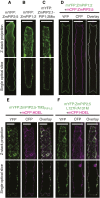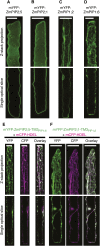A new LxxxA motif in the transmembrane Helix3 of maize aquaporins belonging to the plasma membrane intrinsic protein PIP2 group is required for their trafficking to the plasma membrane
- PMID: 24989232
- PMCID: PMC4149701
- DOI: 10.1104/pp.114.240945
A new LxxxA motif in the transmembrane Helix3 of maize aquaporins belonging to the plasma membrane intrinsic protein PIP2 group is required for their trafficking to the plasma membrane
Abstract
Aquaporins play important roles in maintaining plant water status under challenging environments. The regulation of aquaporin density in cell membranes is essential to control transcellular water flows. This work focuses on the maize (Zea mays) plasma membrane intrinsic protein (ZmPIP) aquaporin subfamily, which is divided into two sequence-related groups (ZmPIP1s and ZmPIP2s). When expressed alone in mesophyll protoplasts, ZmPIP2s are efficiently targeted to the plasma membrane, whereas ZmPIP1s are retained in the endoplasmic reticulum (ER). A protein domain-swapping approach was utilized to demonstrate that the transmembrane domain3 (TM3), together with the previously identified N-terminal ER export diacidic motif, account for the differential localization of these proteins. In addition to protoplasts, leaf epidermal cells transiently transformed by biolistic particle delivery were used to confirm and refine these results. By generating artificial proteins consisting of a single transmembrane domain, we demonstrated that the TM3 of ZmPIP1;2 or ZmPIP2;5 discriminates between ER and plasma membrane localization, respectively. More specifically, a new LxxxA motif in the TM3 of ZmPIP2;5, which is highly conserved in plant PIP2s, was shown to regulate its anterograde routing along the secretory pathway, particularly its export from the ER.
© 2014 American Society of Plant Biologists. All Rights Reserved.
Figures








Similar articles
-
Trafficking of plant plasma membrane aquaporins: multiple regulation levels and complex sorting signals.Plant Cell Physiol. 2015 May;56(5):819-29. doi: 10.1093/pcp/pcu203. Epub 2014 Dec 16. Plant Cell Physiol. 2015. PMID: 25520405 Free PMC article. Review.
-
An N-terminal diacidic motif is required for the trafficking of maize aquaporins ZmPIP2;4 and ZmPIP2;5 to the plasma membrane.Plant J. 2009 Jan;57(2):346-55. doi: 10.1111/j.1365-313X.2008.03691.x. Epub 2008 Sep 21. Plant J. 2009. PMID: 18808456
-
The LxxxA motif in the third transmembrane helix of the maize aquaporin ZmPIP2;5 acts as an ER export signal.Plant Signal Behav. 2015;10(3):e990845. doi: 10.4161/15592324.2014.990845. Plant Signal Behav. 2015. PMID: 25897469 Free PMC article.
-
FRET imaging in living maize cells reveals that plasma membrane aquaporins interact to regulate their subcellular localization.Proc Natl Acad Sci U S A. 2007 Jul 24;104(30):12359-64. doi: 10.1073/pnas.0701180104. Epub 2007 Jul 16. Proc Natl Acad Sci U S A. 2007. PMID: 17636130 Free PMC article.
-
Aquaporin trafficking in plant cells: an emerging membrane-protein model.Traffic. 2013 Jun;14(6):629-35. doi: 10.1111/tra.12062. Epub 2013 Mar 14. Traffic. 2013. PMID: 23425337 Review.
Cited by
-
Trafficking of plant plasma membrane aquaporins: multiple regulation levels and complex sorting signals.Plant Cell Physiol. 2015 May;56(5):819-29. doi: 10.1093/pcp/pcu203. Epub 2014 Dec 16. Plant Cell Physiol. 2015. PMID: 25520405 Free PMC article. Review.
-
Plasma Membrane-Type Aquaporins from Marine Diatoms Function as CO2/NH3 Channels and Provide Photoprotection.Plant Physiol. 2018 Sep;178(1):345-357. doi: 10.1104/pp.18.00453. Epub 2018 Aug 3. Plant Physiol. 2018. PMID: 30076224 Free PMC article.
-
Transmembrane Helices 2 and 3 Determine the Localization of Plasma Membrane Intrinsic Proteins in Eukaryotic Cells.Front Plant Sci. 2020 Jan 10;10:1671. doi: 10.3389/fpls.2019.01671. eCollection 2019. Front Plant Sci. 2020. PMID: 31998350 Free PMC article.
-
Plasma membrane aquaporins interact with the endoplasmic reticulum resident VAP27 proteins at ER-PM contact sites and endocytic structures.New Phytol. 2020 Nov;228(3):973-988. doi: 10.1111/nph.16743. Epub 2020 Jul 13. New Phytol. 2020. PMID: 33410187 Free PMC article.
-
The Grapevine Uncharacterized Intrinsic Protein 1 (VvXIP1) Is Regulated by Drought Stress and Transports Glycerol, Hydrogen Peroxide, Heavy Metals but Not Water.PLoS One. 2016 Aug 9;11(8):e0160976. doi: 10.1371/journal.pone.0160976. eCollection 2016. PLoS One. 2016. PMID: 27504956 Free PMC article.
References
-
- Ayadi M, Cavez D, Miled N, Chaumont F, Masmoudi K. (2011) Identification and characterization of two plasma membrane aquaporins in durum wheat (Triticum turgidum L. subsp. durum) and their role in abiotic stress tolerance. Plant Physiol Biochem 49: 1029–1039 - PubMed
-
- Barlowe C. (2003) Signals for COPII-dependent export from the ER: What’s the ticket out? Trends Cell Biol 13: 295–300 - PubMed
Publication types
MeSH terms
Substances
Associated data
- Actions
- Actions
- Actions
- Actions
LinkOut - more resources
Full Text Sources
Other Literature Sources

